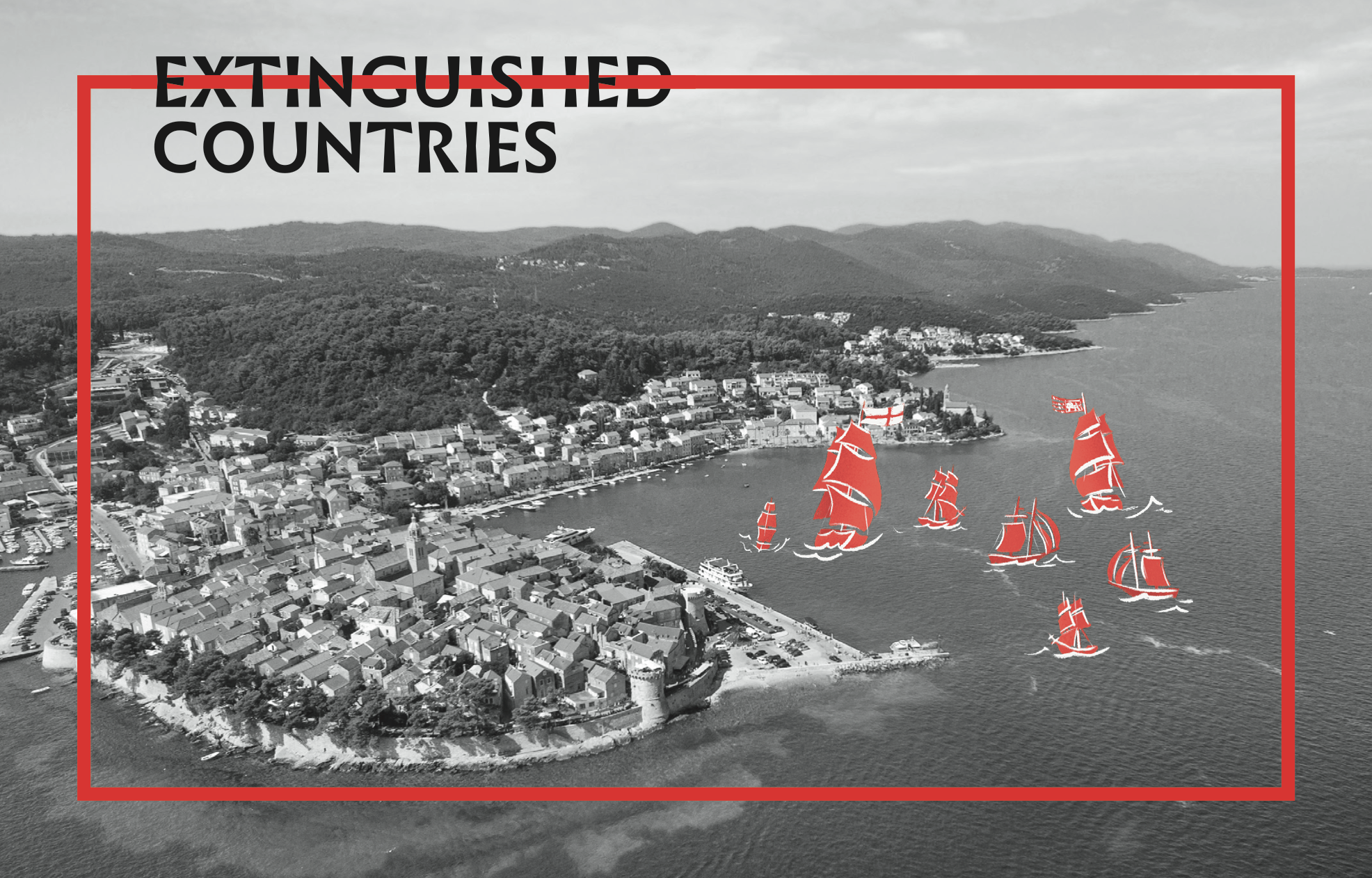
In a preview for readers of OBC Transeuropa, some pages of a guide dedicated to the Republic of Venice, which will be published at the end of the year – the first volume of the series "Extinguished Countries"
The sea unites, the sea divides. This is the oscillation that has characterised the relationship between the two shores of the Adriatic over time. Croatia shared a very long season with the Serenissima. Istria and Dalmatia were part of the Republic for three, four, even five centuries depending on the location. Together they experienced the rise, the wars with the Ottomans fought side by side, the decline, and the end. In Venice, where Dalmatians have their own school, dozens of streets, squares, and bridges are dedicated to these lands. Above all, the Champs-Élysées of Venice: the Riva degli Schiavoni.
"From Lošinj to Cattaro, the families of shipowners and captains would get rich and buy a house in Venice. Croatians became one of the strongest communities in the lagoon and over time an economic, cultural, and artistic relationship developed that influenced both sides", explains Croatian historian Lovorka Čoralić. From the nineteenth century onwards, however, history was reinterpreted. For Croatian nationalism, Venice became an okupator, while in Pula, Mussolini defined Croatians as "an inferior race". The Second World War and the exodus of many Italians from Croatia ended up polluting that relationship for many decades to come.
Today, fortunately, historiography has freed itself from the weight of ideologies, and relations in the Adriatic have improved considerably. The trip to Croatia will take you to territories that have "a relationship of love and hate" for Venice, in the words of Croatian ethnologist Tomislav Pletenac. You will find traces of the Venetian heritage in architecture and dialect, in art and gastronomy. You will meet the many Italian communities still present and discover a seafaring culture which, better than anything else, will make you relive this vanished state.
The islands
More than 1,200 islands and islets are scattered along the coast of Croatia. We move from the northernmost ones, located in the Kvarner bay, to the southernmost ones, off the coast of Split and Ragusa. About fifty are inhabited all year round, but they come alive especially in summer, when millions of tourists arrive. Visiting these islands, perhaps on a sailboat, is the best way to understand how the Republic of Venice worked, through a constellation of ports, bays, and towns facing the sea. So forget the roads and follow the maritime routes to discover Dalmatia.
The three main islands of Kvarner – Krk, Cres, and Lošinj – have a very different past. The largest and closest to the coast, Veglia, was the domain of the Frangipane counts since the 11th century. The deterioration of relations between the counts and the Serenissima led in 1481 to the deposition of the former and the passage of the island under the direct control of the Republic. Cres, on the other hand, was Venetian from the 12th to the 14th century, before being definitively purchased in 1409 (together with the rest of Dalmatia, for 100,000 ducats). Finally, the most distant island, Lošinj, only developed from the 16th century, although today it is more populated and touristy than Cres.
"In the 15th century, the first Venetian settlement on the island of Cres, Òssero (Osor), was affected by malaria. Since then, the role grew of the city of Cres, which for this reason today features a completely Venetian architecture", says Jelena Dunato, director of the Cres Museum. Over time, the current capital of the island became a fishing and shipbuilding centre (today you can see the loggia, the tower with the clock, the walls, and many buildings). In Veglia, the walls, gates, and a tower remain, while of great interest, on the islet of Cassione, is the Franciscan convent from 1447, with a very rich library.
Going down, we meet Pag, today called the Croatian Ibiza because of the discos on Zrće beach. At the time of the Serenissima, it was known, more prosaically, for its salt flats (and the cheese, which is still produced today). In the archipelago of Zadar, the history of Silba is linked to the Morosini, feudal lords of the island until the early 19th century, while Uglian and Pasman as well as the long island (Dugi Otok) emerge in the Venetian chronicles for the transfers of populations of the 16th-17th centuries, when communities fleeing the Dalmatian hinterland arrived here. Further south, the inhabitants of Morter purchased over time the beautiful Kornati, where today there is an excellent museum of wooden boats.
In general, the islands are a separate universe in Croatia. Not only the culture changes (ask around what pomalo and fjaka mean), but also the problems of everyday life: from the supply of drinking water to connections with the mainland. Whether small or large, all the inhabited islands have their own identity, complete with local parochialism. In the summer, the fešte (festivals) give you a glimpse of island life, but a winter stay will earn you the respect of the inhabitants. If you want to try the experience, consider that the southern islands are the sunniest... as well as the most important for Venice.
Curzola (Korčula), for example, not only marks the entrance to the Adriatic for those arriving from Corfu or Venetian Albania, but is also on the border with the Republic of Ragusa, whose territories begin with the Peljesac peninsula. Over the centuries, Venice encouraged viticulture here, so much so that in 1525, one hundred years after its entry into the Serenissima (1420), "63% of the island's surface is covered with vineyards", writes Swiss historian Oliver Jens Schmitt in Korčula sous la domination de Venise au XVe siècle. Almonds, figs, and pitch for the arsenal would also come from the island.
As elsewhere on the Dalmatian coast, also in Korčula there were frequent clashes between nobles and the people, who did not hesitate to go to the Doge himself to assert themselves. The Gabrieli (seat of the civic museum), Ismaeli, and Arneri palaces testify to the wealth of some families, while the so-called “Marco Polo's house” deserves a separate discussion. The building dates back to the 15th century, well after the birth of the famous traveler (1254), but it is the origin of a local tradition that believes that Marco Polo was born right here, a point of view that is indigestible among Venetians to say the least.
Today, the "house" is a museum dedicated to the Silk Road and the battle of Korčula (1298). In that clash between Venetians and Genoese, Marco Polo was taken prisoner and, during his detention in Genoa, he dictated his famous “Il Milione” to Rustichello da Pisa. However, it was not the only battle off the coast of this island. Korčula's walls and ramparts, partly destroyed in the late 19th century, are proof of its military role, as is the religious festival of August 15th, which recalls the Ottoman attack of 1571, which failed – it is told – thanks to the intervention of the Holy Mary (the Ottoman fleet then routed to nearby Hvar and set it on fire).
But that is not all. The warrior dance called moreška, which spread in the Mediterranean at the time of the Crusades, is still staged in Korčula during the summer (the less violent, Greek-inspired kumpanija also survives). The rich archives of the island then record many cases of smuggling, typical of a border town (in particular, salt was sold in Drijeva, a point of contact with the Ottoman Empire, today in Gabela in Bosnia and Herzegovina). Finally, the loggia, the Terraferma gate, the many Marcian lions, and the treasures contained in the cathedral (by sculptor Marko Andrijić) complete the picture of Renaissance Korčula.
One last curiosity: in the brotherhood of All Saints (Svi sveti) you will find Orthodox icons that were allegedly brought from Crete during the war in Candia (1645–1669). This is not the only legacy of that conflict. The village of Račišće, 13 km west of Korčula, was founded in the 17th century with the arrival of refugees from the Dalmatian hinterland. The same happened in Sumartin on the island of Brač, while new groups of inhabitants also arrive in Sućuraj (in Lesina/ Hvar), along the Makarska Riviera and, as we have seen, in the Zadar archipelago (the expelled Muslims from Dalmatia take refuge in Bosnia instead).
Leaving Korčula you can visit Hvar, Brac, and Solta, guided by Petar Hektorović. In 1568, the Croatian poet published in Venice his famous “Fishing and the fishermen's speeches”, a travel diary in verse which is one of the very first texts in Croatian. In Stari grad, on Hvar, the Hektorović palace remains with inscriptions in Latin, Italian, and Croatian carved by the poet. On the same island, but in the city of Hvar, it is also worth visiting the 1612 arsenal which contains one of the oldest theatres in Europe, recently renovated (at its entrance there is the figurehead of the ship of Hvar that fought in Lepanto).
Finally, in Lissa (Vis) there are two Venetian towers and a castle (in Comisa/ Komiža), now home to the fishing museum. But above all, this island is also linked to a naval battle which, despite taking place after the end of the Serenissima (1797), helps us understand the legacy of this vanished state and the process of formation of national identities. It was the summer of 1866 and in these waters the Kingdom of Italy, born a few years earlier, faced the Austro-Hungarian Empire, which for a few decades had controlled the former territories of the Republic of Venice, including the lagoon city.
The Habsburg navy then included Venetians, Istrians, and Dalmatians, while on the ships of the Italian navy there were Piedmontese, Tuscans, Neapolitans, or Sardinians and Sicilians, united for the first time under the same banner. The imperial fleet wins and from its ships the typical war cry of the Serenissima rises: Long live San Marco! In Italian historiography, the defeat of Lissa is seen as an example of the poor integration (including linguistic) between the various navies of united Italy and as a proof of the different souls of the young kingdom. It was almost a challenge between seas: Adriatic against Tyrrhenian.
Useful info
Work tools, equipment for fishing and navigation, documentaries and model ships... the museum of Betina catapults you into the traditions of the Adriatic.
The historical regatta Latinsko Idro also sails from Morter every year.
On Facebook, follow the group "Hrvatski Drveni Brodovi" (in multiple languages), while on the island of Vis, discover the history of Falkuša , including with organised excursions.
In Korčula, despite the destruction caused by phylloxera in the 19th century, wine production has resumed: Pošip, Plavac Mali, and Grk are some of the local wines to try. On the gastronomic side, we also mention the makaruni of Žrnovo and the typical dishes called čipi čapi (an offal goulash with polenta) and the sweet focaccia called lojenica.
In Hvar, don't miss St. Stephen's Cathedral (located on the largest square in Dalmatia), the loggia, and the fortress that dominates the city. To the south-west of the island, the archipelago Pakleni otoci owes its name to a kind of pitch (paklini) that was spread on the keel of the ships. Therefore, they are erroneously called "infernal islands" (from pakao, hell), while in fact they were just full of bays to repair boats.























 To Top
To Top